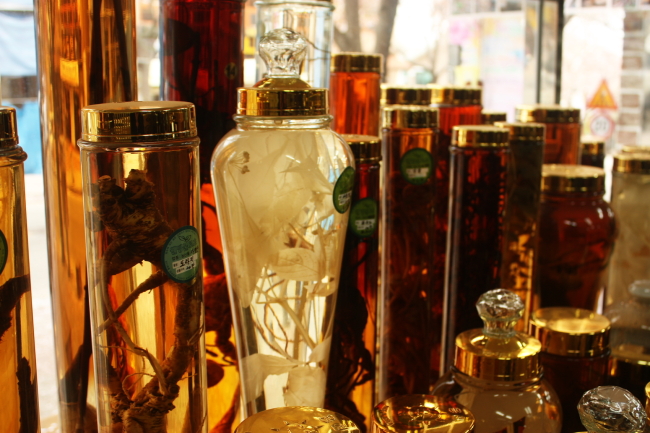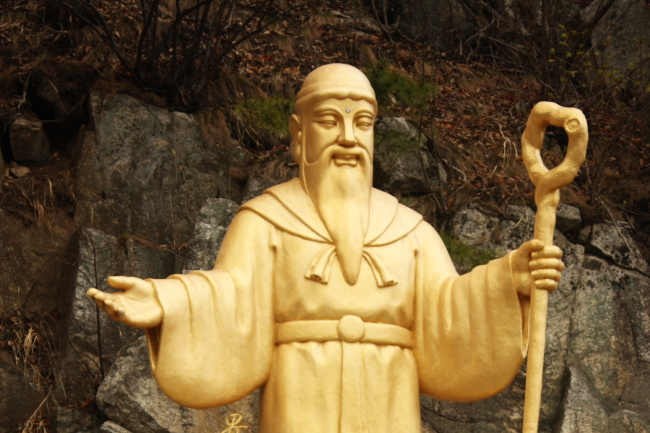As sometimes happens on Korean hiking excursions, it proved hard at Mount Moaksan to move beyond the approach and onto the mountain itself. Aside from the usual series of restaurants, serving hearty dishes like barley bibimbap, the trailhead area had attractions of a more arcane nature, and even a few riddles.
One such attraction was a store named The Herb of Everlasting Life. Lined up behind the display window were glass cylinders of mountain ginseng in alcohol, alongside other stamina roots like deodeok and bellflower. Inside were entire wasps’ nests, bottled and preserved for 450,000 won ($430), and flasks of wasp whiskey selling for 30,000 won. Fitting snugly in a thin bottle was a bamboo shoot, almost a meter long, as well as other medicines, the names of which do not show up in dictionaries.
Working in a corner and paying no mind to the visitors was the black-bearded proprietor, more of a backwoodsman than a Taoist immortal.
Further up the road, looking like someone who might have had one too many cups of the elixir of life, was a cartoonish statue of Dangun, the mythical founder of the first Korean kingdom, depicted here as a short old man with a white beard and wooden staff.
 |
Bellflower root (left) and mountain ginseng (second from left) are sold at Bulnocho (The Herb of Everlasting Life) near the east entrance of Moaksan Provincial Park. (Matthew Crawford/The Korea Herald) |
 |
A statue of Dangun the mythical founder of Korea, stands at a hermitage owned by the Seondo Culture Research Center at Moaksan Provincial Park. (Matthew Crawford/The Korea Herald) |
An explanatory signboard quoted the German philosopher Martin Heidegger and the former French President Jacques Chirac, who reportedly once said, “In other countries, holy men appeared during times of trouble, but in Korea the country itself was founded by a holy man.”
Next to this was a detailed chart on the founding lineage of the Korean race. Starting from Dangun in B.C. 2333 and ending in B.C. 238, the chart covered 47 generations in great detail, despite the fact that all this was prehistory. It was unclear who or what agency had put up the display.
Heading now toward the rounded hills of Mount Moaksan, layered one behind the other, the smoky, gray air seemed about as opaque as the Dangun mystery.
Passing chains of elementary school children on field trips, and then the stone guardians and burial mound of the progenitor of the Jeonju Kim family, the trail led up to a forested ridge. The ground had been dug up in spots by wild boars looking for tasty roots, probably for sustenance rather than their medicinal powers.
A chance side trip along a path to Cheonilam Hermitage led to what appeared to be a Buddhist hall and a line of meditation cabins. Here a signboard introduced an ancient text called the “Cheonbugyeong,” which it claimed was passed on orally from the Hanguk Era (B.C. 7197-B.C. 3896) and translated into Chinese characters during the Silla Kingdom by the great scholar Choi Chi-won.
While said to explain the logic behind the creation of the universe, the actual text, 81 characters long and attributed to Hwanoong, father of Dangun, seemed rather nebulous: “The One is One which has both a beginning and no beginning. / It is the eternal origin, separated into three poles.”
An employee came out of an administrative office and politely fielded questions. Thin and wiry, with an angular jaw and glasses, Lee Jae-cheol stressed that this was not a Buddhist hermitage, but belonged to the Seondo Culture Research Center. The organization was founded by Lee Seong-heon, who meditated here when it was still a Buddhist retreat and discovered that the roots of Korean culture were not in Buddhism or Confucianism but in Seondo Culture.
Seondo, literally “the path of the immortals,” was an indigenous philosophy which spread into China to become Taoism, he explained. And the goal of the research center was to restore this original Korean culture through proper education.
Lee conceded that the “Cheonbugyeong” text was not well known in Korea, and that unless you’ve been trained in the tradition, its message is inscrutable.
He also mentioned that Mount Moaksan was a holy mountain associated with Dangun, but without clarifying how so. Shrines to Dangun can be found on Mount Taebaeksan in Gangwon Province and Mount Manisan on Ganghwado Island, Gyeonggi Province, though scholars posit that the peak that Hwanoong, Dangun’s father, was supposed to have descended to from the sky was either Mount Myohyangsan or Mount Baekdusan in North Korea.
Moving up to the summit, claimed by broadcasting towers and KBS facilities painted with camouflage designs, there was a limited view from the binoculars on the helipad. On clear days, views extend to Jeonju in the north, and far beyond.
Back at the bottom, but on the other side, the large sandy compound of Geumsansa Temple provided an opportunity to investigate the roots of Korean Buddhism, with no fewer than 11 national treasures residing there.
 |
Since being burned down and rebuilt, Mireukjeon Hall has stood for about 380 years at Geumsansa Temple, Moaksan Provincial Park. (Matthew Crawford/The Korea Herald) |
An icon of the provincial park, the three-tiered hall of Mireukjeon has managed to survive the past 380 years after being rebuilt in 1635, following the Japanese invasions of the late 16th century. Supported by huge pillars, the hall contains a golden Maitreya statue flanked by two bodhisattvas staring down from a great height.
Nearby stand a pagoda and the Bangdeung Gyedan, a two-level platform said to contain relics of the historical Buddha. After his death in B.C. 483, his cremated remains were divided up, and 200 years later the Indian emperor Ashoka redistributed the remains to 84,000 stupas across his domain. Another 600 years later, the religion made its way into Korea.
Could the Bangdeung Gyedan possibly contain genuine relics of the Buddha, as is also claimed of many other sites throughout Korea? For those lacking faith, Mount Moaksan ― “Mother Mountain” ― is a place of many questions and few answers.
Getting there:
From close to Jeonju’s express bus and intercity bus terminals, city bus No. 970 bound for Gui travels to the east side of Moaksan Provincial Park. No. 79 goes to the west side, near Geumsansa Temple.
By Matthew C. Crawford (
mattcrawford@heraldcorp.com)










